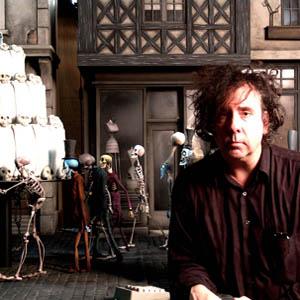Appearing at the recent launch of his Melbourne exhibition, Tim Burton cuts a shy, unassuming figure. Hidden behind oversized sunglasses he talks in a quiet, almost awkward manner. When asked about his upbringing in Burbank, California he confesses that he “didn’t speak much” as a child. As he retreats from the media I get the sense that Burton feels far more at home in the world of his private imagination than in front of a gathered crowd.
Seeing Tim Burton in person it’s easy to imagine where he finds the inspiration for the reclusive characters that litter his films. Ever since Vincent (1982), his animated short about a shut away child who idolises scream-king Vincent Price, the director has maintained a strong fascination with the social outcast. Batman (1989), Edward Scissorhands (1990), Ed Wood (1994), Sleepy Hollow (1999), Planet of the Apes (2001), Big Fish (2003), Charlie and the Chocolate Factory (2005), and Alice in Wonderland (2010) all revolve around figures out of place in the worlds they inhabit.
Likening the assemblage of his work (previously presented at New York’s Museum of Modern Art) to an “archaeological dig”, even Burton seems genuinely surprised by the size of this collection. Spanning the breadth of his career, the ACMI exhibition is dominated by the director’s drawings, sketches and storyboards, amidst various props, costumes, sculptures and design models from his films. However, it’s in the hand-drawn images that one finds the various motifs that have long been associated with his cinematic work.
Revealing his fascination with the carnivalesque, Burton’s figures are marked by a playful exaggeration of angle and shape – spindly arms and obese torsos – and by abject amalgamations – human-insect forms and man-machine combinations proliferate throughout. If Burton’s cinema draws its inspiration from the German Expressionist filmmakers and the work of Ray Harryhausen then his drawings also echo the art of Ralph Steadman.
While auteur theory (the notion of the director as key to a film’s artistic meaning) has become somewhat unfashionable of late, this exhibition works to confirm Burton as centrally important within the studio production process. Even though the filmmaker is quick to point out the group aspect of cinema – he lovingly refers to various long-time collaborators as his “weird family” – the overall vision on show here is of an almost unchanging, child-like fascination with misfits and macabre gothic fairy tales.
For fans of the director’s work there is plenty to be excited about within the exhibition, particularly the rarely seen, made-for-television Hansel and Gretel (1982), which is screening in its entirety. For me though, the real highlight is Burton’s doodle pad, still encased in its leather cornered desk mount, and covered in a chaotic mix of scribbled figures, spirals and other forms. That the work should be tucked away at the far end of the space, outcast from the main exhibits, and yet provide such an open glimpse into this private man’s imagination, seems to me the height of clever curatorship.
Tim Burton: The Exhibition runs until October 10th at ACMI, Melbourne
For further information see: www.acmi.net.au/timburton.aspx





